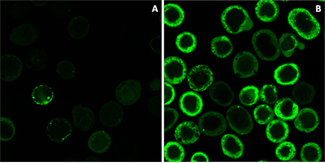Bacterial chaperones to improve protein production in insect cells

Recombinant DNA technology boosted the production of recombinant proteins with industrial or therapeutic applications, which transformed biotechnological industry. Despite this, recombinant protein production in heterologous systems is not yet optimized, and these proteins are often obtained as insoluble deposits. Choice of an appropriate expression system is important for proteins to be produced in a soluble and functional form. In this thesis, a recombinant GFP has been used as a model protein to study aggregation and biological activity during recombinant protein production in Escherichia coli and the baculovirus expression system.
In E. coli, our model protein is obtained mainly as highly active inclusion bodies. Our results show that although protein solubility can be enhanced by optimizing several parameters in the production process, conditions promoting high production levels result in decreased conformational quality of the protein. Since it is not possible to enhance simultaneously production yield and quality, process design should be optimized depending on the most relevant feature for the final use of the protein.
Moreover, the soluble version of this protein contains a wide range of soluble aggregates, which constitute a heterogeneous population regarding secondary structure and functionality of the protein. This indicates that inclusion bodies, being more homogeneous than their soluble counterparts, can be regarded as a narrow subpopulation among all the recombinant protein species. Moreover, the quality of the recombinant protein represents a statistical average of the quality of each of these species.
One of the most widely used strategies to improve solubility of recombinant proteins consists of coexpressing folding modulators. When the bacterial chaperone pair DnaK/DnaJ was coexpressed in E. coli together with our model GFP, we observed a decrease in aggregation, which was associated to proteolysis. Rehosting of these chaperones, together with our model protein, to the baculovirus expression system (using either cultured insect cells or larvae as hosts) allowed us to maintain the foldase activity of DnaKJ while avoiding their associated proteolytic activity, as it is dependent on bacterial proteases. By using the baculovirus expression system, we observed enhanced production levels (both total and soluble), proteolytic stability, solubility and biological activity of our recombinant protein when it was coexpressed with bacterial chaperones DnaKJ. Furthermore, the concept that yield and quality of the recombinant protein are antagonistic parameters that cannot be favored simultaneously in production processes has been proven in a eukaryotic system.
Finally, we have also demonstrated that bacterial chaperones are functional in a eukaryotic system. This expands the catalogue of folding modulators available for eukaryotic systems.
References
"Engineering and Production of Quality Viral Proteins in Prokaryotic and Eukaryotic Systems". PhD thesis defended by Mònica Martínez Alonso on 16 February at 12:00 in the Sala de Graus of the Facultat de Biociències.


